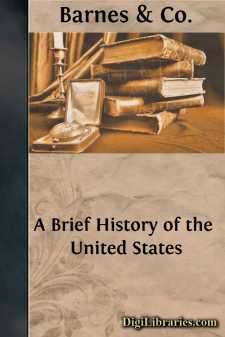Categories
- Antiques & Collectibles 13
- Architecture 36
- Art 48
- Bibles 22
- Biography & Autobiography 813
- Body, Mind & Spirit 142
- Business & Economics 28
- Children's Books 15
- Children's Fiction 12
- Computers 4
- Cooking 94
- Crafts & Hobbies 4
- Drama 346
- Education 46
- Family & Relationships 57
- Fiction 11828
- Games 19
- Gardening 17
- Health & Fitness 34
- History 1377
- House & Home 1
- Humor 147
- Juvenile Fiction 1873
- Juvenile Nonfiction 202
- Language Arts & Disciplines 88
- Law 16
- Literary Collections 686
- Literary Criticism 179
- Mathematics 13
- Medical 41
- Music 40
- Nature 179
- Non-Classifiable 1768
- Performing Arts 7
- Periodicals 1453
- Philosophy 64
- Photography 2
- Poetry 896
- Political Science 203
- Psychology 42
- Reference 154
- Religion 513
- Science 126
- Self-Help 84
- Social Science 81
- Sports & Recreation 34
- Study Aids 3
- Technology & Engineering 59
- Transportation 23
- Travel 463
- True Crime 29
A Brief History of the United States
by: Barnes & Co.
Description:
Excerpt
EARLY DISCOVERIES AND SETTLEMENTS.
[Illustration: BALBOA.]
GEOGRAPHICAL KNOWLEDGE IN THE FIFTEENTH CENTURY.—The people of Europe had then never heard of America. About that time, a great desire for geographical knowledge was awakened. The compass and the astrolabe—an instrument for reckoning latitude—had been already invented. Voyagers were no longer compelled to creep along the shore, but began to strike out boldly into the open sea. The art of printing had just come into use, and books of travel were eagerly read.
[Footnote: Questions on the Geography of the First Epoch.—In the accompanying map there are no divisions of the continent, as none existed at that time. When they are called for in the following questions, the object is to test the pupil's geographical knowledge.
Locate the West Indies. San Salvador (now called Guanahani, gwah-nah-hah'-ne, and Cat Island). Cuba. Hispaniola or Hayti (he-te), name given to the island in 1803 by Dessalines. (See Lipp. Gazetteer.) Newfoundland. Cape Breton. Roanoke Island. Manhattan Island.
Describe the Orinoco River. Mississippi River. St. Lawrence River.
James River. Ohio River. Colorado River. Columbia River. St. John's
River (see map for Epoch V).
Where is Labrador? Central America? Florida? Mexico? New Mexico?
California? Oregon? Peru?
Locate St Augustine. Santa Fe (sahn-tah-fay). New York. Montreal.
Quebec. Albany. Jamestown. Port Royal. Isthmus of Darien. Cape
Henry. Cape Charles. Cape Cod. Chesapeake Bay. Hudson Bay.
Marco Polo and other adventurers returning from the East, told wonderful stories of the wealth of Asiatic cities. Genoa, Florence, and Venice, commanding the commerce of the Mediterranean, had become enriched by trade with the East. The costly shawls, spices, and silks of Persia and India were borne by caravans to the Red Sea, thence on camels across the desert to the Nile, and lastly by ship over the Mediterranean to Europe.]
The great problem of the age was how to reach the East Indies by sea, and thus give a cheaper route to these rich products.
COLUMBUS conceived that by sailing west he could reach the East Indies. He believed the earth to be round, which was then a novel idea. He, however, thought it much smaller than it really is, and that Asia extends much further round the world to the east than it does. Hence, he argued that by going a few hundred leagues west he would touch the coast of Eastern Asia. He was determined to try this new route, but was too poor to pay for the necessary ships, men, and provisions.
[Footnote: Several facts served to strengthen the faith of Columbus in the correctness of his theory. The Azores and the Cape de Verde islands were the most westerly lands then known. There had been washed on their shores by westerly winds, pieces of wood curiously carved, trees, and seeds of unknown species, and especially the bodies of two men of strange color and visage.]
[Footnote: Christopher Columbus was born in Genoa, Italy, 1435. He was trained for the sea from his childhood. Being the eldest of four children, and his father a poor wool-comber, much care devolved upon him....


